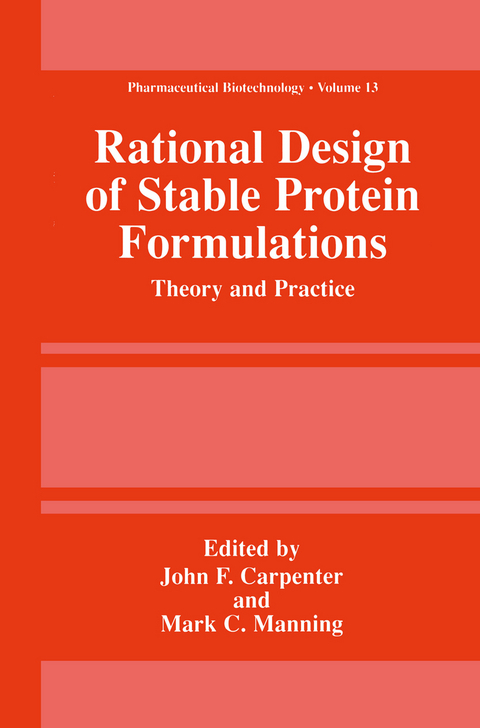
Rational Design of Stable Protein Formulations
Springer-Verlag New York Inc.
978-1-4613-5131-3 (ISBN)
This book describes the current level of understanding of protein instability and the strategies for stabilizing proteins under a variety of stressful conditions.
1 Practical Approaches to Protein Formulation Development.- Preparation for Formulation Development.- Preformulation Development.- Formulation Development.- Formulation in Commercial Product Development.- Appendix: List of Regulatory Documents.- References.- 2 Recombinant Production of Native Proteins from
Escherichia coli.- Distribution of Expressed Proteins.- Cell Washing and Lysis.- Purification of Soluble, Folded Proteins.- Purification and Refolding of Soluble, Misfolded Proteins.- Purification and Refolding of Proteins from Inclusion Bodies.- Refolding Mechanism.- Methods to Analyze Folded Structures.- References.- 3 Physical Stabilization of Proteins in Aqueous Solution.- Overview of Physical Stability.- Interactions of Excipients with Proteins.- Physical Factors Affecting Protein Stability.- Conclusions.- Appendix: Derivation of the Wyman Linkage Function and Application to the Timasheff Preferential Exclusion Mechanism.- References.- 4 Effects of Conformation on the Chemical Stability of Pharmaceutically Relevant Polypeptides.- Relationship Between Structure and Deamidation Rates.- Role of Structure in Protein Oxidation.- Summary.- References.- 5 Rational Design of Stable Lyophilized Protein Formulations: Theory and Practice.- Minimal Criteria for a Successful Lyophilized Formulation.- Rational Design of Stable Lyophiilized Formulations.- Acknowledgments.- References.- 6 Spray-Drying of Proteins.- Introduction: Why Spray-Dry a Protein?.- Developments in the Last 10 Years.- The Practice of Spray-Drying Proteins.- Concluding Remarks.- References.- Chapter7 Surfactant-Protein Interactions.- Proteins and Surfactants at Surfaces.- Protein-Surfactant Interactions in Solution.- Surfactant Effects on Protein Assembly State.- Surfactant Effects on Proteins During Freezing, Freeze-Drying and Reconstitution.- Enzymatic Degradation of Non-Ionic Surfactants.- Recommendations for Protein Formulation.- References.- 8 High Throughput Formulation: Strategies for Rapid Development of Stahle Protein Products.- Overall Structure of the HTF Approach.- Role of an Established Decision Tree for Formulation Design.- Use of Software and Databases to Assist in the HTF Process.- Essential Analytical Methods.- Stability Protocols.- Unified Strategy for HTF.- References.
| Erscheint lt. Verlag | 30.10.2012 |
|---|---|
| Reihe/Serie | Pharmaceutical Biotechnology ; 13 |
| Zusatzinfo | XVII, 206 p. |
| Verlagsort | New York, NY |
| Sprache | englisch |
| Maße | 155 x 235 mm |
| Themenwelt | Medizin / Pharmazie ► Medizinische Fachgebiete ► Pharmakologie / Pharmakotherapie |
| Medizin / Pharmazie ► Pflege | |
| Medizin / Pharmazie ► Pharmazie ► PTA / PKA | |
| Naturwissenschaften ► Biologie ► Biochemie | |
| Technik ► Umwelttechnik / Biotechnologie | |
| ISBN-10 | 1-4613-5131-6 / 1461351316 |
| ISBN-13 | 978-1-4613-5131-3 / 9781461351313 |
| Zustand | Neuware |
| Informationen gemäß Produktsicherheitsverordnung (GPSR) | |
| Haben Sie eine Frage zum Produkt? |
aus dem Bereich


